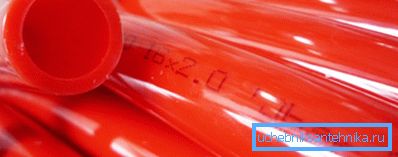Polyethylene pipes for heating: advantages and weak points
In the production of pipes, polyethylene has been used for quite a long time, but a serious problem was the low resistance of the material to temperature changes. Polyethylene pipes for heating have not been used until recently, but with the advent of the so-called crosslinking technology, polyethylene has acquired new unique qualities, which we will discuss.
Cross-linked polyethylene for heating has nothing to do with welding or soldering, as it may seem at first glance. In fact, this is a special processing of the material by one of several currently existing methods, which are selected depending on the use of pipes.

What is the secret of popularity
Despite the fact that the material appeared relatively recently, in most European countries its share in the market of heating systems is currently approaching 50%. It is caused by the indisputable advantages of pipes made of cross-linked polyethylene for heating.
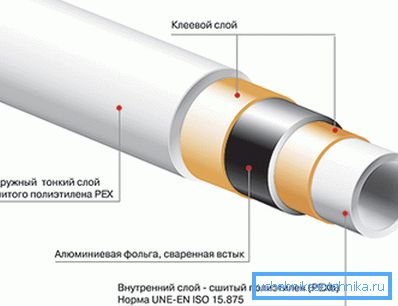
Material advantages
- After special treatment of the product made from this material, under the condition of lack of pressure, they are able to withstand temperatures up to +200? С, without deformation. As is well known, most heating systems use water as a coolant, the heating of which in the network rarely exceeds 90? С. With such initial data, pipes for heating of cross-linked polyethylene can withstand up to 8 atm and at the same time manufacturers guarantee normal operation for 50 years.
- Also an important advantage is a large lower temperature threshold.. The material does not lose its stated properties when the temperature drops to -50? С. On such a frost, the surface of the products not only does not crack, but also retains its normal elasticity.
- Unlike metal, processed polyethylene acquires resistance to all types of corrosion.. Such pipes can easily withstand both internal and external exposure to aggressive environment.

- In some systems, special reagents must be added to the coolant, which can later lead to a reduction in the service life of structures.. So on the cross-linked pipes, regardless of the composition of the coolant, no scale or scurf is formed.
- This material has such a unique property as internal memory.. In other words, if the product is bent or slightly deformed, over time it gradually returns to its original forms, without sacrificing technical characteristics. This feature is widely used when installing systems.

- The small weight of the products is convenient not only in the process of transportation, but also in terms of installation. The load on the supporting structures is not so significant that these lines can even withstand drywall or modern heat insulating materials with a cellular structure.
- Installation of such lines does not cause difficulties even for a little trained people.. Laying can be performed according to any scheme, the bends and turns of these lines are not terrible. And more importantly, the connection of pipes is easily done by hand with a minimum set of tools.
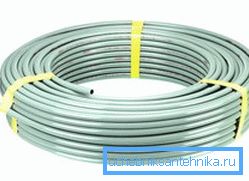
- In case of freezing of water in the system, the polyethylene pipe for heating will only slightly expand.. Moreover, as mentioned earlier, after thawing, it again quickly restores the former geometric forms.
- Cross-linked polyethylene for heating, according to all international standards is considered to be completely environmentally neutral. This is indicated by the fact that all these products are allowed to operate in systems that transport drinking water.
Important: the price of accessories for the installation of pipes made of cross-linked polyethylene for heating a private house is quite acceptable for almost any budget.
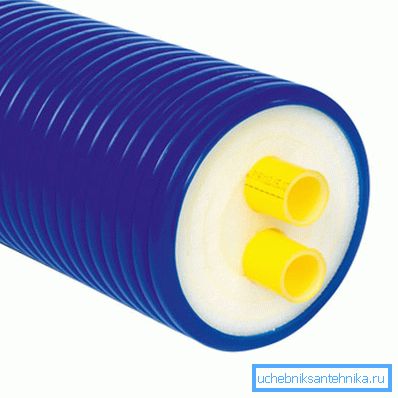
What are the weak points
- In fact, there are not so many weak points in this material. But, as in any product, they are still there. In particular, opponents point to a fairly high flammability of polyethylene. At a temperature of 400 ° C and above, the material melts and simply drains.
- Strong, chemically active reagents, such as nitric acid, can irritate the surface of a heating pipe made of cross-linked polyethylene. But by and large, no sane person will start pumping in or pouring acid on top of pipes in his own house.
- Despite the ease of installation, any instruction indicates that the connecting elements and joints of the structure must not be poured into the screed or hidden under a layer of plaster. They are a weak point of the heating system and nine out of ten leaks occur precisely in the joints.

- Polyethylene in general and cross-linked material in particular is afraid of direct sunlight.
- And finally, all consumers point to the relatively high cost of cross-linked polyethylene pipe for heating. Although if you look at it, only copper can boast of similar characteristics, but the price for it is incomparably higher. Really high-quality goods can not be cheap.
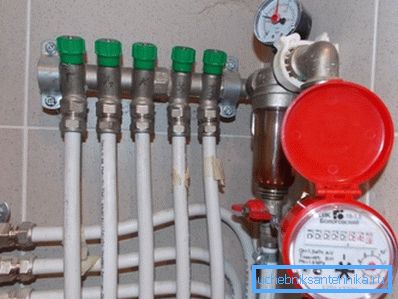
Regulations
Cross-linked polyethylene for heating is classified according to GOST 52134-2003, which is the same for all products of a similar plan made from plastic. The following is a table of averaged data of cross-linked polyethylene, compiled on the basis of the above regulatory document.
| Mechanical data | +t? C | Units | Calculated values |
| Density | 20 | g / cm? | 0.95 |
| Material tensile strength | 20 | MPa | 22 - 27 |
| Elongation at break | 20 | % | 350 - 550 |
| Elastic modulus index | 20 | MPa | 550 and more |
| Impact index | 20 | kJ / cm? | 441 |
| Shore Strength Index | 20 | - | 64 |
| Vicat Hardness Index | ISO 306 | ?WITH | 124.5 |
| Moisture absorption rate | 100 | % | 0.05 |
| Thermal data | |||
| Zone of constant use | ?WITH | -100 / + 120 | |
| Softening temperature index | ?WITH | 132 | |
| Linear expansion coefficient | 20 | ?WITH-one | 1.4 x 10-four |
| Linear expansion coefficient | 100 | ?WITH-one | 2 x 10-four |
| Specific heat index | 20 | kJ / kg? C | 2 |
| Thermal conductivity coefficient | W / m? S | 0.35 - 0.41 | |
| Electrical data | |||
| Indicator of specific internal resistance | 20 | Ohm | ten-15 |
| Dielectric constant | 20 | 2.2 | |
| Breakdown voltage indicator | kW / mm | 20 or more |
Connection methods
Heating made of cross-linked polyethylene, as a rule, is not soldered or boiled. All connections are made using two types of fittings, these are compression or clamping and pressure fitting.

Clamp fittings
Compression fittings are considered the simplest and most accessible type of connection. Any good owner who is able to change the tap in the house, with his own hands and without much effort will be able to carry out the installation of this type.
To work, in addition to the clamping fitting itself, you need only a standard set of wrenches. It is also desirable to have a special secateurs for even cutting of the pipe, but, in extreme cases, you can do with a hacksaw (only in the case of a hacksaw, after cutting, you must remove the chamfer from the pipe).

Initially, a cap nut will be put on the exactly cut pipe. The next step is to install a split sealing ring of the fitting going into the kit. The ring should be about a millimeter from the edge of the pipe.
All this construction is turned up to the stop in the union. Next, the crimping nut is carefully wound and tightened with wrenches of the appropriate size to the fitting.
Important: any type of plastic, including cross-linked polyethylene, has relatively low mechanical strength, so you need to carefully tighten, without fanaticism, so that the split ring does not squeeze out or the pipe itself is damaged.
Installing a press fitting

This type of installation is considered more reliable and durable. The only disadvantage here is that the connection will not be detachable. If necessary, the old fitting is cut off and pressed on a new one.
Doing a home set of tools also fail. For pressing you will need a special expander and a manual or hydraulic press.
The press-on process itself is not very complex; it is no more difficult to do this kind of work with your own hands, if you have a tool, than installing a compression fitting.
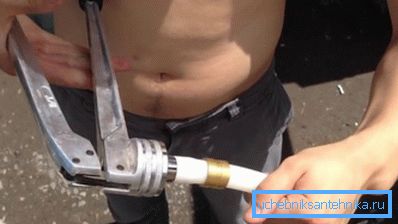
As in the first case, a pressing sleeve is put on the pipe. After that, with a special expander designed for a given diameter of products, the pipe is stretched.
Tip: when the extender is turned all the way and the tube is moved apart, you should fix it in this position for a few seconds.
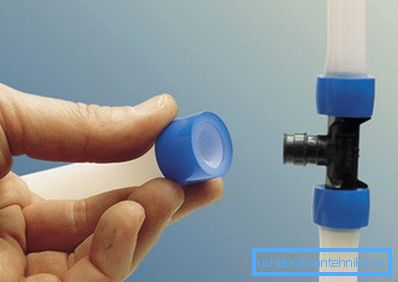
Next, you should quickly remove the pipe from the expander and put it on the fitting until it stops. The sleeve advances and is pressed on top of the connection. As already mentioned, pipes for heating of cross-linked polyethylene have the so-called internal memory. Returning to the original position after exposure to the expander, the pipe will tighten fitting. The sleeve at the same time plays the role of an additional locking element.
The video shows the important points of operation and installation of pipes made of cross-linked polyethylene.
Conclusion
In conclusion, it should be said that pipes made of cross-linked polyethylene for heating do not require any action after the installation of the structure. The system can be immediately launched without preparation.
